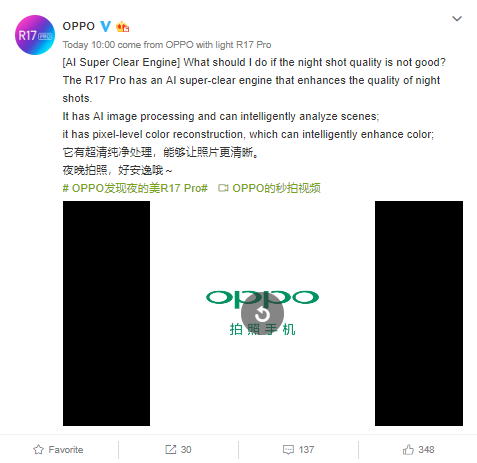OPPO has confirmed that it will be launching the OPPO R17 and R17 Pro smartphones on Aug. 23 though a launch event in Shanghai. Recent reports have suggested that the R17 and R17 Pro may sport identical specs, but the latter seems to be packed with advanced photography features. The R17 is expected to arrive with a basic AI dual camera. However, R17 Pro is equipped with features like variable aperture and Optical Image Stabilization (OIS). Today, the Chinese manufacturer has released a new video to reveal that the AI Super Clear Engine present on the R17 Pro will allow it to capture good quality night shots through AI.
The below video reveals that the OPPO R17 Pro features AI Super Clear Engine improves the quality of night shots by analyzing the scenes through AI image processing. Then there is pixel-level color reconstruction begins for intelligently enhancing the colors in the images. The third step involves the process of making the photos appear clearer.
Apart from AI Super Clear Engine, the R17 Pro will come with Smart Aperture feature that will allow users to manually switch between f/1.5 and f/2.4 aperture. Some reports have started that the R17 Pro may feature triple camera setup on its rear. However, the company is yet to confirm it.
Read More: OPPO F9 is official with 6.3-inch waterdrop display, VOOC flash charging and AI 25MP selfie camera
OPPO is yet to confirm on the specifications of the OPPO R17 Pro. As far as the OPPO R17 is concerned, the handset will be coming with a 6.4-inch AMOLED display with waterdrop notch. It could be the first phone from the company to feature sixth generation Gorilla Glass protection.
The Snapdragon 670 SoC may power the phone along with 8 GB of RAM. It will be arriving with a native storage of 128 GB. The handset is packed with a 3,500mAh battery that carries support for flash charging. For photography, it features a front-facing camera of 25-megapixel and on it rear is a dual camera setup that includes 16-megapixel primary sensor and 5-megapixel secondary sensor.
(source)








